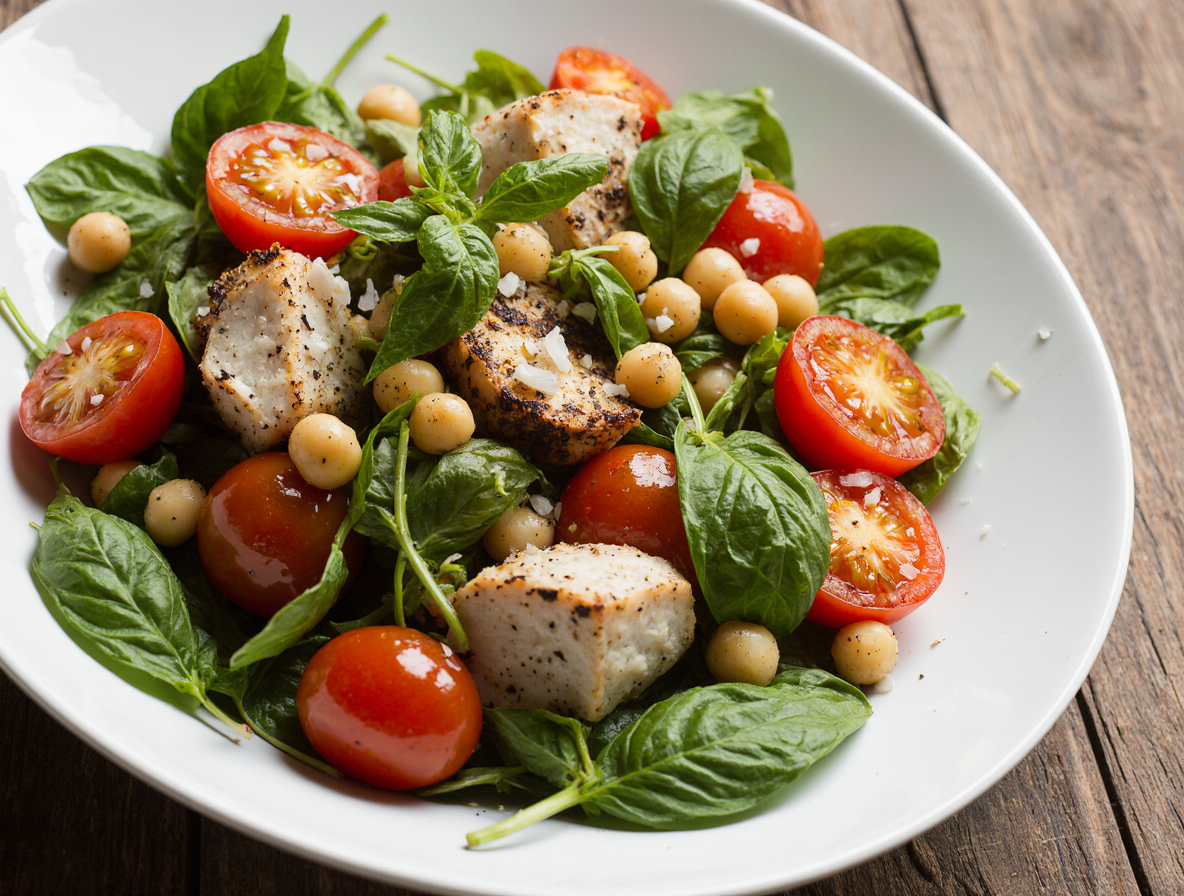How to Make High-Protein Salad Recipes: A Chef’s Secret Guide
Did you know that high protein salad recipes can pack a whopping 38 grams of protein per serving?
That’s right! As a chef, I’m constantly amazed by how these nutritional powerhouses combine incredible flavor with substantial nutrition. A 20-minute vegan Tomato & Basil Salad with chickpeas and artichoke hearts delivers both plant-based protein and remarkable taste in one bowl.
When looking for healthy salads with protein, ingredients make all the difference. Chickpeas, for instance, aren’t just protein-rich — they also provide fiber that helps reduce cholesterol and manage blood sugar levels. Additionally, protein-packed ingredients like pistachios contribute essential nutrients including potassium and iron. In fact, eating more legumes like chickpeas has been linked to lower risk of heart disease.
What’s particularly exciting about salads high in protein is their versatility. From simple tomato-based creations loaded with vitamins A and C for immune support to more complex combinations, these meals offer both nutrition and satisfaction. In this guide, I’ll share my chef’s secrets for creating perfect high protein salad ideas that will transform how you think about these nutritious meals.
Choosing the Right Ingredients for Protein Salads
Selecting the right proteins transforms ordinary salads into nutritious powerhouses. The protein content varies widely – chicken breast offers 26 grams per 3 ounces, while canned tuna provides an impressive 40 grams per cup.
For meat-free options, legumes reign supreme. Chickpeas deliver 12g of protein per cup and simultaneously improve cholesterol levels. Lentils contain nearly 9g per 100g while offering folate, manganese, and iron. Furthermore, tofu (16.5g per 100g) and tempeh (20.7g per 100g) make excellent complete protein additions.
Seeds and nuts contribute significantly to protein content despite their small size. Hemp seeds stand out with 30g protein per 100g, providing all nine essential amino acids. Similarly, pumpkin seeds (24.4g per 100g) and peanuts (25.8g per 100g) make nutritious toppings.
Don’t overlook eggs (6g per large egg) or cheese options like parmesan (10.1g per ounce). Even grains like quinoa (4.4g per 100g) help boost overall protein.
Consequently, the best high protein salad recipes combine multiple sources – perhaps beans with nuts, or chicken with seeds. This approach not only increases protein content but also enhances texture and flavor profiles. Above all, variety ensures you receive a complete spectrum of amino acids and complementary nutrients.
Step-by-Step: How to Make a High-Protein Salad
Creating the perfect high protein salad begins with properly preparing your greens. First, wash and thoroughly dry your greens using a salad spinner. Before adding any dressing, season your naked greens with salt and pepper to create a base layer of flavor.
Next, prepare your protein components. Aim for 4-5 ounces of animal protein like grilled chicken or salmon, or plant-based options such as tofu or lentils. Combining multiple protein sources yields better results—perhaps chickpeas with crispy tofu or tuna with cannellini beans.
The secret to exceptional texture lies in contrasting elements. Add crunch with toasted seeds, nuts, or roasted chickpeas. Pumpkin seeds are especially versatile and toast quickly, while a 5-seed mix can contribute both protein and healthy fats.
When assembling, place heavier ingredients at the bottom, then add delicate items. For dressing, drizzle it along the walls of your bowl rather than directly onto greens. Afterward, toss gently with your hands to incorporate air and distribute ingredients evenly without bruising leaves.
Finally, if meal-prepping, store components separately—especially crunchy toppings, which should be kept in airtight containers. This approach prevents sogginess and maintains the perfect texture in your protein-packed creations.
Customizing and Storing Your Salad
Making high protein salad recipes truly your own requires smart customization and proper storage techniques. The beauty of protein-packed salads lies in their adaptability—swap grilled chicken for salmon or turkey based on your preferences. Going plant-based? I substitute lentils, tofu, cottage cheese, hard-boiled eggs, or a combination of chickpeas and hemp seeds.
For meal prep success, store components separately. I line containers with paper towels to absorb excess moisture, keeping greens crisp for up to 10 days. Hence, a container with paper towels outperforms other storage methods. Moreover, I keep dressings on the side until serving time, preventing soggy leaves.
Mason jars make excellent vessels for layering ingredients—place heavier items at the bottom and delicate greens on top. Subsequently, these layered creations can last several days in the refrigerator.
To maximize freshness:
- Run greens through a salad spinner to remove moisture
- Store in airtight glass containers (preferable to plastic)
- Inspect produce before prepping and discard wilted leaves
- Keep crunch elements like nuts and seeds in separate containers
With minimal effort, these protein salad recipes can become weekday staples that maintain both nutrition and flavor throughout your busy week.
Conclusion
High-protein salads offer far more than just nutritional value. Throughout this guide, we’ve explored how these versatile dishes combine remarkable flavor with substantial protein content. Chickpeas, lentils, tofu, and animal proteins like chicken and tuna transform ordinary salads into satisfying meals that support your health goals.
The secret to exceptional protein salads lies not just in ingredient selection but also in preparation techniques. Properly seasoning greens before adding other components creates a foundation of flavor. Additionally, contrasting textures through crunchy elements like toasted seeds or nuts elevates the entire eating experience.
Most importantly, these protein-packed creations adapt to your personal preferences and lifestyle. Whether you prefer plant-based options or animal proteins, the fundamental principles remain the same. Smart storage techniques likewise extend freshness, making protein salads practical for busy weekdays.
After years as a chef, I’ve found that high-protein salads represent the perfect intersection of nutrition, taste, and convenience. They offer endless possibilities for customization while delivering substantial nourishment. The next time you’re seeking a satisfying meal, remember that a well-crafted protein salad provides both immediate enjoyment and lasting energy. Your journey toward delicious, protein-rich meals starts with the simple techniques shared in this guide.
FAQs
Q1. How much protein can I expect from a high-protein salad? A well-crafted high-protein salad can provide up to 38 grams of protein per serving, making it a nutritious and satisfying meal option.
Q2. What are some good plant-based protein sources for salads? Excellent plant-based protein sources for salads include chickpeas, lentils, tofu, tempeh, hemp seeds, and quinoa. These ingredients not only boost protein content but also add variety to your salad.
Q3. How can I keep my salad fresh when meal prepping? To keep your salad fresh, store components separately, use paper towels to absorb moisture, keep dressings on the side, and use airtight glass containers. This approach can help maintain freshness for up to 10 days.
Q4. What’s the best way to add crunch to a high-protein salad? Add crunch to your salad with toasted seeds, nuts, or roasted chickpeas. Pumpkin seeds are particularly versatile and can be quickly toasted for added texture and nutrition.
Q5. How should I layer ingredients when assembling a protein salad? When assembling your salad, place heavier ingredients at the bottom and add delicate items on top. For dressings, drizzle along the walls of your bowl rather than directly onto the greens to ensure even distribution without sogginess.


